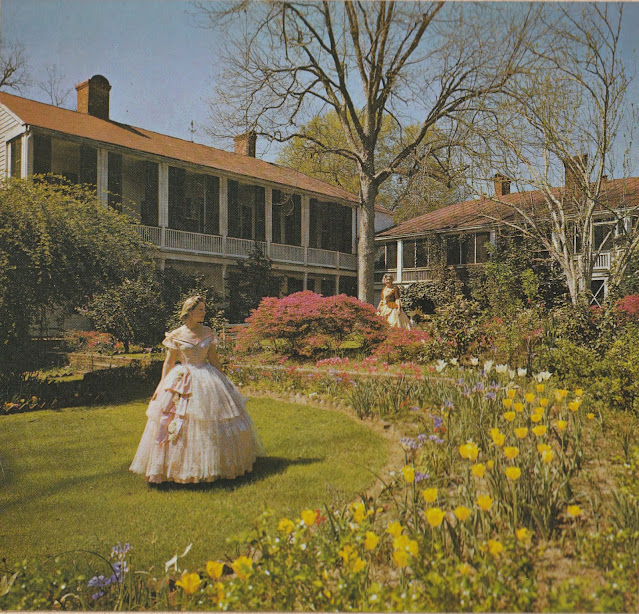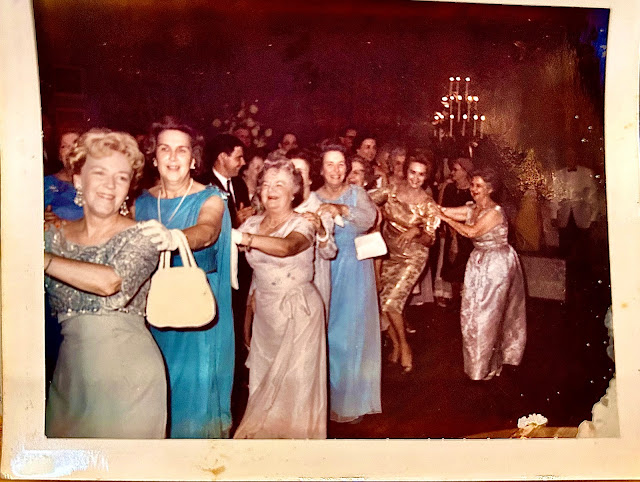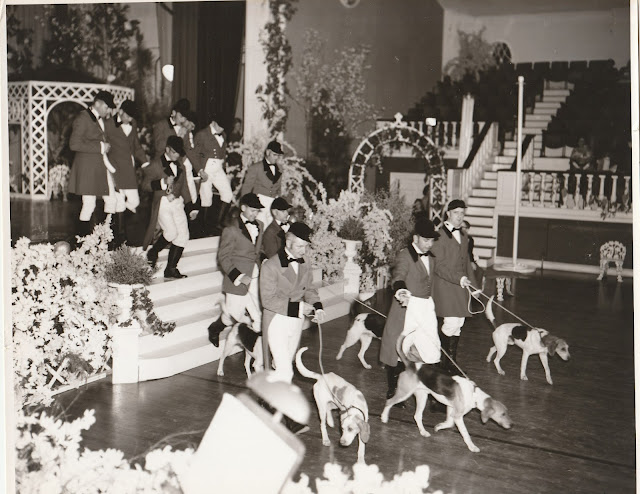Some days it's hard to love
Shantybellum
Pull up an ice chest or a cotton bale, peel yourself a crawfish, make yourself comfortable and have some fun at the coolest little shack in town.
Search This Blog
Friday, January 5, 2024
Swimming Underwater
Some days it's hard to love
Sunday, November 19, 2023
Tommye Lu Foresman Pritchartt: A Talented Lady
My father's third wife was Tommye Lu Foresman from Alligator, Mississippi. Yes, there really is an Alligator, Mississippi up in the Delta. My father and Tommye Lu had an ⏤ let's say, interesting ⏤ relationship. It was all love/hate and drama. They both enjoyed a good argument.
And Daddy was enchanted not only by pretty women, but especially pretty women who sang and played the piano. Lots of fights accompanied by lots of music.
They would have these huge fights that echoed off the walls of the huge house they inhabited in the country. Once, when I brought my baby girl home to visit, they were having a particularly lively argument. They sounded like dinosaurs fighting, and the house shook with fear.
"Oh, shut up, you sonofabitch!"
Once Daddy said she got mad at one of her sons and called him a sonofabitch. He would remember and fall into helpless gales of laughter.
I had begun to think bitch and jackass were terms of endearment.
When you grow up in these environments, you don't realize how unusual it is. You think all parents are like that. But on a trip home and seeing my daughter's little chin quivering, I demanded:
"If you two don't stop shouting, I'm taking Annet and staying someplace else. It's scaring her."
They were well behaved the rest of the day.
Daddy told me that once their friend Martha Curry had been out visiting. As often happened Daddy and T Lu got into it. Finally, Martha said, "Look. I've got to go." I'm sure she just wanted out of there.
"No! No," screamed TLu. "You can't leave me here with him. He'll kill me!"
"No, he won't," said the all-suffering Martha."
T-Lu had met Martha the day she was supposed to marry Daddy and ⏤ in true T-Lu style ⏤ had forgotten to make a hair appointment. She came running into the salon in her wedding dress, begging the stylist to do her hair. Martha offered her her own appointment and they were fast friends after that. Daddy and TLu hosted a wedding at their house for her daughter's wedding.
(Back to the fight)
"Well, then listen," said Tommye Lu, "...if you haven't heard from me in two hours, call the sheriff."
Martha dutifully promised she would do so and drove home where it was quiet.
A few minutes later, the fight is over and forgotten about. They BOTH did that. You'd think they'd never speak to you again and five minutes later, it's over.
"We were having champagne out here on the front porch," said Daddy, the corner of his lip slightly curled.
"All of a sudden we hear this, 'WOOP! WOOP! WOOP!, and red and blue lights flashing."
'Oh, my God! I forgot to call Martha!" Tommye Lu exclaimed. And there was the sheriff, waving and laughing at the nicest domestic violence call he'd ever received.
Sometimes their fights would get so bad, they'd each go to a lawyer and have divorce papers written up, ready to use them at a moment's notice. They kept them in separate bank boxes. Daddy went so far as to buy Tommye Lu a house downtown in the garden district. He called it "Her Pouting House." They could fight and she could go stay at her pouting house for a week or two.
Tommye Lu liked to talk while she prattled about the house. But my father really enjoyed his solitude. He also had his own little hideaway. Just a few feet into the woods, Daddy put a small metal shed. He brought a cot into the room. He had a window-unit air conditioner for summer and a space heater for the winter. He covered the windows with cardboard so she couldn't see the lights at night.
See, Daddy knew that Tommye Lu was scared to death of snakes and would never, ever, not even once, step into those woods. So even though it was but a few feet from the house, she never knew about it. He would lie on the cot, read the newspapers, listen to a portable radio, pass wind and open a can of sardines and eat an onion. Or a can of Spam. Eddie Albert had nothing on Howard Pritchartt for the joys of farming.
Then one day I got a call from Daddy, saying he'd been on the tractor all day and his lower leg was swollen and hurting. So he went to see Dr. Tillman the next day who told him it was a blood clot and he had to be admitted and stay perfectly still. He would send him up to Jackson by ambulance the next day.
The night before they were to leave, Daddy said he was lying in bed.
"Tommye Lu had been upset all day because she'd dropped a mirror and it broke. She believes that stuff and had been upset all day."
Tommye Lu had just stepped out of the shower and was walking toward Daddy when she suddenly stumbled and grabbed her head.
"Baby? You all right?"
"I'm really dizzhzhhhy," and one side of her face went limp. She'd always had high blood pressure, and they both knew what had happened. He rushed down to her side where she lay, naked and afraid. She looked up at him and pulled his face down to hers and gave him a long, hard kiss.
"She was just lying there, naked. She looked so beautiful, but we both knew this was bad."
Despite the divorce papers, the fights, the disappointments and the joys, the fun, the laughter, the good times and the bad, there was still so much love.
"Where the hell is the ambulance?" he cried.
It had been 45 minutes. He called again. They said they were having trouble finding it. This was before Garmin, iphones and google maps. Finally, an hour and a half later, they arrived and had her flown to the hospital in Jackson and admitted in ICU.
Meanwhile, Daddy had his own blood clot and was riding by ambulance to the same hospital. He was on one floor; she was on another.
"They won't let me go see her," he said, pulling at my arm. I'd just flown in from Los Angeles. I'll go up and check on her and I'll be back."
This went on for several days. My stepbrothers, Tom and Ed Foresman, were by her side the whole time. But after a few days, they told us she was beyond help. I had to leave Daddy in the hospital. I can't remember why now but I had to get back for something.
A couple of weeks later, Daddy was up and walking, and Tommye Lu passed quietly away. I remember it was in October. 1995, perhaps?
I'd never seen real grief before that day. It shocked me. I'd been there when his parents, his friends, would pass away. But I'd never seen his shoulders so slumped, his face so downcast. He was shattered in every way.
"I never understood it before," he said. "I understand it now."
He would read the names in the funeral register, over and over noting who hadn't come, hadn't called. To him, friendship was sacred. I don't think he ever forgave them. At least it gave him someone to be angry at.
One night he was going through pictures. "I remember this day," he said "It was cold outside. We'd had an ice storm.
I woke up and looked outside. She was out there holding King Cat (her Siamese) and was wearing a fur coat. God, you know that was the only thing she had on? Nothing else. The sad, faraway look in his eyes spoke of a morning spent doing intimate, unspeakable things, a fire burning in the fireplace while the trees snap and drop branches and fall all around the forest, and thinking that life is just perfect. And it was. For awhile.
Monday, November 6, 2023
85th Anniversary of the Pilgrimage Garden Club's Acquisition of Stanton Hall
 |
| Photo by Michael Chapman |
I've been asked to tell the history of Stanton Hall, but that story can't be told without the story of Natchez. Natchez isn't simply a town to those who've lived their lives here. It's its own character, like in a novel. The people here love this town in ways most people don't understand. Natchez is a member of the family. We all grew together.
We all know that Natchez is the oldest town on the Mississippi River, and also one of the wealthiest enclaves in the country before the Civil War. Having plantations across the river in the Louisiana Delta, wealthy landowners built their townhouses (or McMansions) in Natchez to impress each other and give and go to the best parties in town. It's always about who has the most toys. Stanton Hall is today's billionaire's space tour. Natchez had more millionaires, per capita, than any other city in the US from about 1820 to 1860.
A 2019 article for The New York Times by Richard Rubin states:
"Make your way around Natchez, Mississippi, and you get the sense that if some people ever got really close to living like European aristocrats in the United States, it happened here."
This is the view Mr. Stanton had from the cupola atop Stanton Hall where he could watch his cotton and other cargo arrive and leave on the many steamboats that carried cargo of all kinds. In this photo, you can see arrows pointing out where the barn was and still remains.Frederick Stanton
Frederick Stanton emigrated to America from Ireland in 1815, and settled in Natchez after marrying Hulda Laura Helm at her father's home, "The Helms," in Kentucky in 1827. In the intervening years, the Stantons lived somewhere on Main Street, at the house "Cherokee" on High Street, and at "Glenwood" on the outskirts of town.
By 1849, Stanton had acquired enough wealth to build his dream home, which he named "Belfast" in honor of his Irish heritage. He bought an entire city block bounded by High, Pearl, Commerce and Monroe Streets for $1,500.
Captain Thomas RoseThe architect and builder of Stanton Hall was Captain Thomas Rose, a master carpenter from England, who executed the construction using classical Greek-Revival details, but also using the latest Italianate designs to give it its own character. Incidentally, Captain Rose was my great, great, great grandfather.
He utilized the 1835 book by Minard Lafever, The Beauties of Modern Architecture, of which I still have his copy, taken to New Orleans for repair before I learned about this lecture. I've found one other first-edition copy online for almost $1,000.
Rose sent regular bills to Stanton for the work, which eventually totalled $83,262.23. This included furnishing the plans for the house, receiving all the materials, and contracting all the carpentry work, the painting, glazing, varnishing, roofing, plastering and sundry work on the interior and exterior.
Edgewood
Elms Court
Rose also built Edgewood, Elms Court and a number of smaller houses in town. Rose signed his work at Elms Court. I read an article online that Rose had asked Stanton if he could sign his work at Stanton Hall and was refused. The article stated that that is the reason the wrought-iron on the porches and balconies of the house were festooned with roses, a mild rebuke for not being able to sign his name.
Rose killed himself in 1860 just before the war for nonpayment of one of the houses he built, having been bankrupted from that nonpayment. No one believed he was really bankrupt, as is indicated by a diary entry by Natchez planter, scientist and historian B.L.C. Wailes, dated January 1860:
"Mr. Thomas Rose, who has made a fortune in and about Natchez, where he has lived for twenty years or more, as a master mechanic, and who is worth not less than $150 thousand, is on board the General Quitman in the charge of his son and a few friends who are taking him to the lunatic asylum in Jackson, having been deranged by the present political excitement (that sounds like me!) and imagines himself ruined and poor. He is a worthy and industrious and sober man, much esteemed. From the present indications in the political arena, there are thousands among the disunionists more mad than he."
On April 28, 1860, the Reverend Joseph Buck Stratton, minister of the First Presbyterian Church, wrote in his diary that, "... he had been sent for to visit the family of Mr. Thomas Rose, who under derangement of mind, shot himself this evening."
The following are some older photos of Stanton Hall.
Stanton Hall, 1938
Historic view from the front balcony of Stanton Hall
Blueprint for Stanton Hall
Frederick Stanton only lived in his beloved "Belfast" for about a month before dying of chronic liver inflammation at the age of 65 in 1859.
Quoting President Emeritus of the Historic Natchez Foundation, Mimi Miller:
"Most Natchez fortunes were wiped out by the Civil War; but Natchez, itself, was spared largely because Natchez voted against secession.
"Not that its elite were opposed to slavery -- most of their fortunes were built on cotton, and thus, on slave labor ,"-- but as Mimi put it, "the town's leading citizens recognized that secession was bad for business -- and crazy."
For the next 34 years, the house was occupied by his widow, Hulda and other Stanton family members. In 1893, Hulda died of apoplexy, which probably meant a stroke. The opulence and size of the house made it a great financial burden on his heirs.
In 1894, Stanton's heirs divided the furnishings and sold the house to the Stanton College for Young Ladies. The college occupied the house until the early 1900s when it was relocated to the nearby home "Choctaw," where it remained until it closed in 1915. Trinity School did the same thing when it moved into the mansion "Magnolia Hall" before building a proper school on the outskirts of town.
Girls at Stanton College in front of Choctaw. From left: Ethel Brandon, Annet Pritchartt (my great aunt). According to artist Noah Saterstrom, Ethel marked the other two as Bertha and Lots.
Annet Pritchartt's report card from Stanton College for Ladies

I also have a yearbook from Stanton College, "The Tadpole," which I also took to New Orleans to be repaired or I'd have brought it with me.
In the early 1900s, the house was again occupied by family members, Mr. and Mrs. A.G. Campbell
In 1917, the house was sold to Luther Childs, and in 1920, was sold to R.T. Clark, who lived there with his family until 1938 when it was bought by the Pilgrimage Garden Club for use as its club headquarters. It remains with the PGC, which uses it as its headquarters, and operates it as a museum, event venue and clubhouse. The club bought Stanton Hall, along with the entire block for $16 thousand. Every woman in the club signed the mortgage, along with their husbands, who also signed in order to guarantee the loan.
Aside from certain gasoliers, mirrors and a smattering of original furniture, the house was essentially empty when the club acquired it, so they pulled together to refurnish it.
Just as the ladies of Natchez had pulled together to create the Pilgrimage, they did the same for Stanton Hall, donating many of their own pieces of silver, crystal, furniture, etc. It wasn't original, and it wasn't necessarily period, but through the years and a lot of research, they've managed to bring the house closer to its original decor, including Stanton family pieces that were returned to the home by family members and their descendants.
Original furnishings when the Stantons lived there."We had a lot of people who were very generous," Mrs. Jenkins said. Some people gave money; some gave their own furniture and other decorative objects. When we had to make a repair, we were always limping around asking for money for Stanton Hall."
Katherine Miller couldn't have children and was in the hospital recovering from a difficult surgery when the nurses told her that all she talked about during her delirium was Azaleas and Camellias and gardens. With no children, it was she who was chosen to do the monster task of getting the word out. And it WAS a monster task.
My father told me that one of his fondest memories is of his best friend, Johnny Ogden, sneaking into the City Auditorium the afternoon before the pageant with a dead fox he'd found beside the road. Dragging the fox by the tail, Johnny made his way up and down the aisles, over and under the seats of the room, laying down a scent and then slipping back outside.
They roared with laughter that evening when during the tableau for The Hunt, the beagles and hounds used for the scene broke their leads and climbed across horrified tourists' laps, baying loudly, drooling, trembling, and peeing with excitement, as they tracked the scent of the long-departed fox.














































.jpg)

















